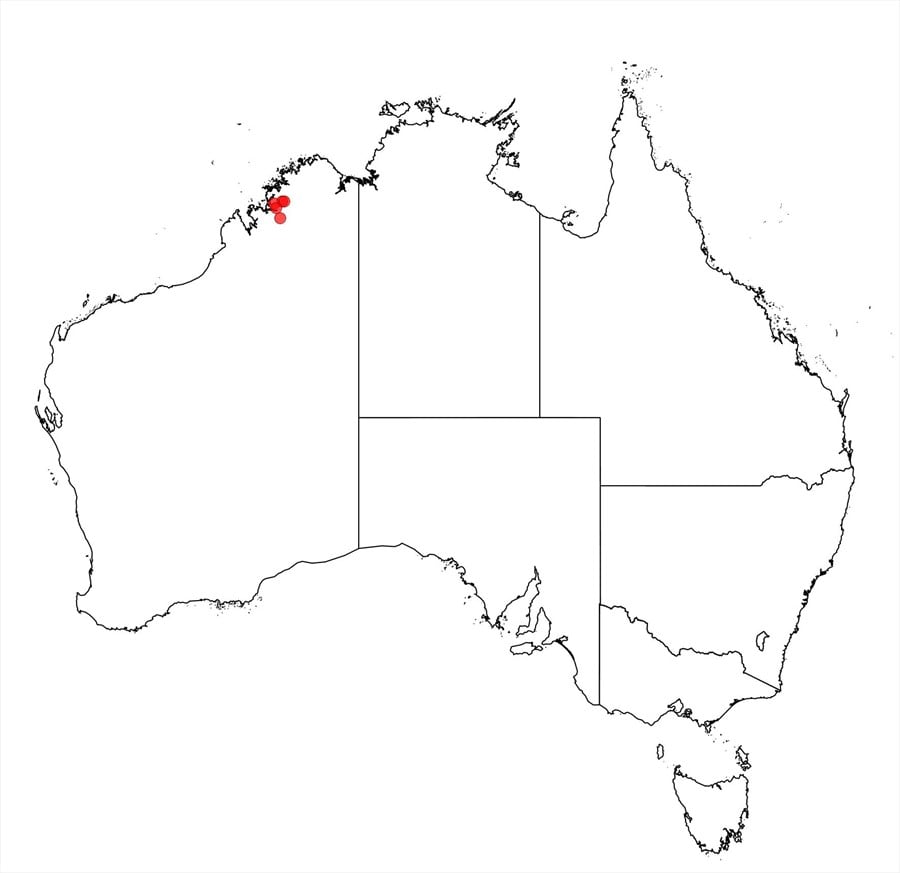Acacia phacelia Maslin, M.D.Barrett & R.L.Barrett
WATTLE
Acacias of Australia
Common Name
Kimberley Cluster-Wattle
Family
Fabaceae
Distribution
Occurs in the NW Kimberley region of northern W.A. where it is known from a few populations 100 km apart, from the Sale R., Edkins Ra., Mt Daglish and Synnott Ra.
Description
Spreading, straggly shrub 0.4–1 (–1.5) m tall. Branchlets slender, terete, ±densely pubescent to pilose. Phyllodes in clusters of (2–) 3–5 (–8) at mature nodes, single on new shoots, commonly narrowly oblong-oblanceolate, shallowly incurved to straight or shallowly sigmoid, flat, mostly 6–10 mm long, 0.7–1.3 mm wide, excentrically mucronate, rostellate or uncinate, ±sparsely pubescent; nerves normally not discernible; gland single, 1–2 mm above the pulvinus. Spikes obloid to short-cylindrical; peduncles (3–) 4–8 mm long, short-pilose. Bracteoles exserted in young buds, the laminae acuminate. Flowers 5-merous; sepals ½–¾ length of petals, free, linear, apically sparsely short-pilose. Pods linear, ±straight, flat but abruptly deflexed at rim to form a perpendicular, narrow, flattened outer edge, quadrangular in section when narrow, 3–8 cm long, 2–4 mm wide, firmly crustaceous, red-brown, longitudinally striate, opening elastically from apex with dehisced valves recurved. Seeds oblique, seated in distinct chambers, 4–4.5 mm long, dark brown to greyish brown except pleurogram bordered by dull cream tissue; areole elongated ‘u’-shaped; aril conical, 1–2.5 mm long, dull cream (when dry).
Phenology
Flowers from Dec.–Jan. and May.–Oct.; few pods with mature seeds normally present on flowering plants.
Habitat
Grows in sparse very open low woodland on shallow sand over and between sandstone ridges.
Specimens
W.A. [localities withheld for conservation reasons] R.L. & M.D.Barrett RLB 4000 (MEL, NSW, PERTH); D.G.Edinger 957 (AD, BRI, CANB, DNA, K, MEL, NSW, NY, PERTH).
Notes
Related to A. conjunctifolia which is most readily distinguished in being a resinous, glabrous species with strongly ribbed branchlets and longer phyllodes that have an evident midrib and non-uncinate apices; it also has generally wider phyllodes, longer spikes and wider pods. Perhaps also related to A. amentifera, a glabrous N.T. species known only from its type, which is further distinguished by its rather prominently ribbed branchlets and ±sessile spikes.
Conservation
Acacia phacelia is listed as Priority Three under Department of Parks and Wildlife Conservation Codes for Western Australian Flora.
FOA Reference
Flora of Australia Project
This identification key and fact sheets are available as a mobile application:
URL: https://apps.lucidcentral.org/wattle/
© Copyright 2018. All rights reserved.






